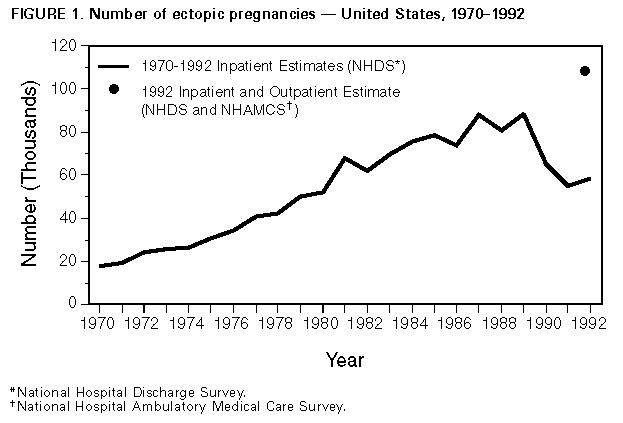 |
|
|
|
|
|
|
|
|
|
|
|
|
|
|
|
|
||||
| ||||||||||
|
|
|
|
Current Trends Ectopic Pregnancy -- United States, 1990-1992Ectopic pregnancy is the leading cause of pregnancy-related death during the first trimester (1). Women who have one ectopic pregnancy are at increased risk for another such pregnancy and for future infertility (2). In the United States, the reported number of hospitalizations for ectopic pregnancy increased from 17,800 in 1970 to 88,400 in 1989 (1). This report summarizes trends in hospitalizations for ectopic pregnancy in the United States during 1990-1992 and presents the incidence of ectopic pregnancy in 1992, based on aggregated inpatient and outpatient data. Data about hospitalizations for ectopic pregnancy were obtained from CDC's National Hospital Discharge Survey (NHDS), a national probability sample of inpatient admissions to noninstitutional general and short-stay hospitals (excluding federal, military, and Veterans Administration hospitals). Data for outpatient diagnosis and treatment of ectopic pregnancy were obtained from CDC's National Hospital Ambulatory Medical Care Survey (NHAMCS), a national probability sample of visits to the emergency and outpatient departments of hospitals with the same characteristics as those sampled in NHDS. Because the actual numbers of ectopic pregnancy in NHAMCS were insufficient to provide a reliable point estimate, data from NHAMCS and NHDS were combined to create an aggregate estimate of ectopic pregnancies treated in both inpatient and outpatient settings in 1992. Data for women treated as outpatients who were subsequently admitted to the hospital were excluded from the combined estimate to avoid double counting. Data were weighted to represent the U.S. civilian, noninstitutionalized population, and 95% confidence intervals (CIs) were calculated using standard errors generated by SUDAAN. Based on NHDS, the estimated number of hospitalizations for ectopic pregnancy in 1990 was 64,400 (95% CI=54,100-74,800) (rate: 11.4 per 1000 reported pregnancies {i.e., ectopic, legal abortions, and live births}); in 1991, 55,600 (95% CI=45,800-65,500) (rate: 10.0); and in 1992, 58,200 (95% CI=48,600-67,700) (rate: 10.6) Figure_1. Based on aggregated data from NHDS and NHAMCS, the estimated total number of ectopic pregnancies in 1992 was 108,800 (95% CI=83,600-134,000) (rate: 19.7 per 1000 reported pregnancies) Figure_1. Reported by: Pregnancy and Infant Health Br, and Statistics and Computer Resources Br, Div of Reproductive Health, National Center for Chronic Disease Prevention and Health Promotion; Ambulatory Care Statistics Br, Div of Health Care Statistics, and Office of Vital and Health Statistics Systems, National Center for Health Statistics, CDC. Editorial NoteEditorial Note: In 1992, ectopic pregnancies accounted for approximately 2% of reported pregnancies, and ectopic pregnancy-related deaths accounted for 9% of all pregnancy-related deaths (3). The findings in this report indicate that, for 1992, the estimated total number of ectopic pregnancies, based on aggregated NHDS and NHAMCS data, was 47% higher than that based on hospitalizations only. Analysis of the estimated number of ectopic pregnancies, based only on hospitalizations, indicates a decline since the late 1980s. This decline may reflect the shift toward treating ectopic pregnancy in an outpatient setting. This hypothesis is supported by the estimated total number of ectopic pregnancies, which suggests that incidence -- instead of declining in the late 1980s -- may have increased steadily since 1970 Figure_1. The increased occurrence of ectopic pregnancy in the United States is consistent with the trend in increased prevalence of important risk factors for ectopic pregnancy, including chlamydia and other sexually transmitted infections (4), induction of ovulation, and tubal sterilization (5). This report is the first to document the incidence of ectopic pregnancy by including information about patients managed and treated on an outpatient basis. Although the addition of the outpatient reports has substantially improved the accuracy of this estimate for 1992, the NHAMCS database does not include patients examined and treated exclusively in physician offices. Therefore, the estimates in this report may underestimate the true incidence of ectopic pregnancy in the United States in 1992. Outpatient management of ectopic pregnancy -- which was first reported in 1987 (6 ) -- is believed to have increased in association with the early detection of unruptured ectopic pregnancies as the result of sensitive radioimmunoassays for human chorionic gonadotropin and high-resolution transvaginal ultrasound (7,8). Outpatient treatment may include laparoscopic salpingectomy or salpingostomy, or methotrexate therapy. In particular, outpatient pharmacologic treatment of ectopic pregnancy with methotrexate has resulted in decreased patient morbidity, a preservation of reproductive capability, and -- when compared with inpatient surgical treatment -- an estimated cost savings of $10,000 per case (9,10). Approximately half of all ectopic pregnancies reported in 1992 involved hospitalization. However, it is unknown whether these women required hospitalization because of more severe disease or because their providers preferred inpatient management. In the inpatient setting, management of ectopic pregnancy has deemphasized more invasive procedures (e.g., laparotomy with salpingectomy) and instead emphasized more conservative procedures, such as laparoscopy with salpingostomy (8). The findings in this report underscore that surveillance and other efforts to monitor national trends in ectopic pregnancy must include women who are treated or managed in both inpatient and outpatient settings. Despite substantial improvements in diagnosis and treatment of ectopic pregnancy, strategies to prevent this condition are needed. Other priorities include increased characterization of risk factors and etiology, and development and implementation of effective interventions. References
Figure_1  Return to top. Disclaimer All MMWR HTML versions of articles are electronic conversions from ASCII text into HTML. This conversion may have resulted in character translation or format errors in the HTML version. Users should not rely on this HTML document, but are referred to the electronic PDF version and/or the original MMWR paper copy for the official text, figures, and tables. An original paper copy of this issue can be obtained from the Superintendent of Documents, U.S. Government Printing Office (GPO), Washington, DC 20402-9371; telephone: (202) 512-1800. Contact GPO for current prices. **Questions or messages regarding errors in formatting should be addressed to mmwrq@cdc.gov.Page converted: 09/19/98 |
|||||||||
This page last reviewed 5/2/01
|